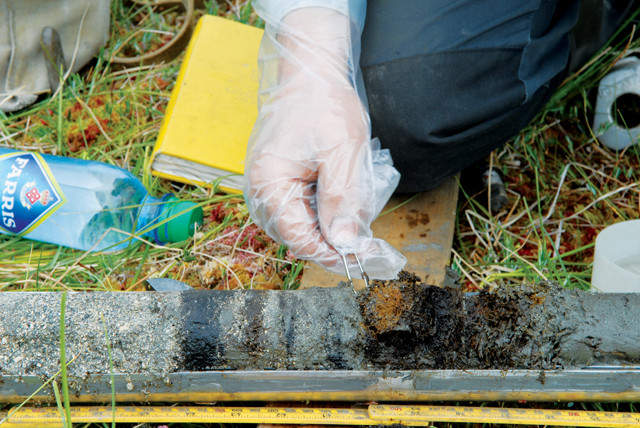
by Julia Rosen Monday, April 20, 2015

The moss found in the tsunami deposit, called Hylocomium splendens, sprouts a new growth segment in the spring that grows until autumn. Credit: Knut Rydgren.
Fishermen trawling Norway’s waters have long known of a place where the seafloor drops precipitously into the abyss. It’s called Storegga — or “great edge” — and it’s actually the steep headwall of the largest undersea landslide in recent geologic history. The slide triggered a tsunami that flooded the shores of the North Sea, reaching as far as Greenland, and likely affecting the Stone Age people that inhabited Northern Europe at the time.
Geologists have previously dated the slide to about 8,150 years ago using materials washed ashore by the tsunami. Now, fragments of moss buried in Norwegian flood deposits have helped narrow the window even further. The plants suggest the disaster struck in late autumn — a time of year that would have been particularly devastating to coastal communities, according to a new study in Geology.
The tectonically quiet North Sea may seem an odd place for a tsunami, but 8,000 years ago, a great ice sheet had just released its frozen grip on Scandinavia. It left behind large deposits of unstable sediments — the product of thousands of years of glacial erosion — on the continental shelf, says David Long, a geologist at the British Geological Survey who did some of the early work on the slide in the 1980s and ‘90s. And while no one knows for sure what triggered the Storegga slide, fracturing of the rebounding ice-free crust is a likely possibility, he says.
The tsunami it produced probably had devastating effects when it struck the shores of Scotland and Norway, where early Europeans lived in houses built close to the water, says Hein Bjerck, an archaeologist at the Norwegian University of Science and Technology who consulted with the authors of the new paper. Flood deposits suggest the tsunami towered more than 10 meters tall in places along the Norwegian coast, and 4 to 6 meters tall in Scotland.
But just how vulnerable these Stone Age civilizations would have been depends on what time of year the tsunami occurred. In the fall, many people would have returned to the coast from the highlands, where they spent the summers hunting. Communities also stood to lose the vital tools and stockpiled supplies they needed to survive the harsh winter.
Previous evidence from tsunami debris — including juvenile fish bones (which display seasonal growth rings) and plant buds and seeds, for example — had pointed to an autumn event, says Knut Rydgren, a biologist and moss specialist at Norway’s Sogn og Fjordane University College and lead author of the new study. The problem is that, while the fish and plants could have perished in the disaster, tsunamis also collect “a lot of dead material,” he says. “So you can’t be sure of the age of the material, or when in the year it died.”
But when Rydgren’s coauthor and colleague at Sogn og Fjordane, Stein Bondevik, found green moss in a tsunami deposit in Hommelstø, he knew the plant had been buried alive. With Rydgren’s help, he hoped to figure out when. Modern specimens of this species of moss, called Hylocomium splendens, exhibit a very predictable growth cycle: In the spring, the plant sprouts a daughter shoot, which grows slowly through the summer, and takes off in early fall. By late autumn, the daughter shoot approaches the size of the mother, and eventually, sprouts an offshoot itself.
The moss samples from the Storegga deposit had daughter shoots close to the size of their mothers, confirming the tsunami’s fall timing. In addition, they lacked new buds, suggesting they were buried before November or December. “We conclude that it happened late in the autumn, probably late in October,” Rydgren says.
It’s safe to assume the seasonal pattern of plant growth hasn’t changed much in 8,000 years, says Nils Cronberg, a moss expert from Lund University in Sweden who was not involved in the work. However, the moss’s growth can be affected by anomalous weather patterns, like a dry summer, leaving some uncertainty in the tsunami’s exact timing, which the authors acknowledge.
It’s also unclear just how the tsunami would have affected ancient populations in the North Sea, Bjerck says. But even without archaeological evidence of the impacts, he says, we can imagine how traumatizing it must have been. “How would they explain a thing like this?” he asks. “They were probably talking about this for many generations.”
© 2008-2021. All rights reserved. Any copying, redistribution or retransmission of any of the contents of this service without the expressed written permission of the American Geosciences Institute is expressly prohibited. Click here for all copyright requests.